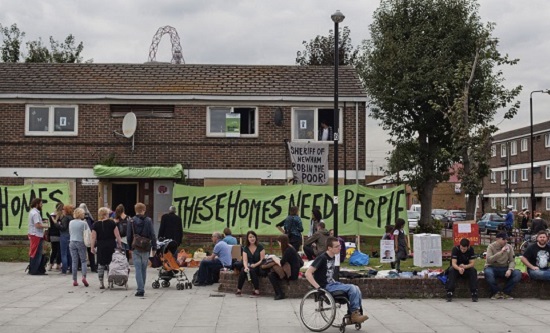
Focus E15 occupied empty flats on the Carpenters Estate, Newham in 2014
Across Britain we are seeing a massive increase in homelessness, with rough sleeping up 169% overall since 2010, and thousands of families forced into temporary accommodation. While people are being evicted and pushed into the streets, more and more homes are being left empty for years on end. Why are so many people without homes while so many homes do not have people?
Street homelessness
It is estimated that more than 4,700 people sleep rough each night in the streets and parks of Britain – a figure that has doubled in the last five years. It includes families with children, particularly migrants who have been refused help from the council, and who have been forced to sleep on night buses, in hospital reception areas and in bin sheds. Increasingly, it also includes the ‘working homeless’, as soaring rent prices especially in London make it unaffordable to pay rent while earnings stagnate.
In London, street homelessness has risen dramatically in the last few years with boroughs like Camden seeing a rise of 647% between the autumn of 2016 and 2017, with local government counts going from just 17 homeless individuals to over 127. Another London borough, Westminster, has the highest number of rough sleepers in the entire country and has seen a string of homeless deaths including a man dying at the door of the houses of Parliament.
Councils across Britain have been criminalising homelessness. In the Royal Borough of Windsor, the council confiscated tents and pushed many rough sleepers out of the area in May – in order that Royalists could camp out along the road ahead of the royal wedding. Last winter, police confiscated tents and personal items from many homeless camps, telling people to seek help from local government instead; in Brighton, homeless people were given just 11 minutes to decamp into freezing conditions on the morning of New Year’s Day; in Bristol, council workers left notes pinned to the possessions of homeless people warning them to move on or have their belongings confiscated. 2017 saw the highest number of recorded homeless deaths at 70. The Metropolitan Police in north London have callously described tent confiscations as dealing with ‘environmental issues’.
Temporary accommodation
While street homelessness is the most visible part of the crisis, many more homeless people, especially families, are staying in temporary accommodation. In March 2018, there were 79,880 households, including 128,000 children, in temporary housing – up nearly 50% since 2013. Most of the temporary accommodation provided is wholly inadequate with disabled people being put in non-accessible flats, and many of the rooms being in bad condition and often dangerous.
Those who protest against this shoddy accommodation face the threat of eviction, and for most there is no alternative. Increasingly, most councils’ ‘solution’ to the housing crisis is to shove working class residents into temporary accommodation and leave them to rot for years. In London, many boroughs resolve statutory rehousing duties by sending homeless families out of the capital altogether, to ‘cheaper’ cities far from relatives, friends, jobs and children’s schools.
The key factors in the rise of homelessness, particularly in London and the southeast are the lack of secure and affordable council housing, on the one hand, and the unaffordability and insecurity of the private rented sector on the other. Across the country, Labour and Conservative councils are demolishing or selling off council housing estates which are then redeveloped as predominantly private tenure housing; other estates are boarded up and left empty as a prelude to ‘regeneration’. The irony is that councils then pay over the odds for private temporary accommodation for those made homeless by their own policies.
Empty homes and abandoned properties
What is so shocking about the current homelessness crisis is that plenty of perfectly habitable homes across the country are being left empty and unused. In London alone, about half of all the new-built luxury flats that dominate the skyline have failed to sell – nearly 20,000 units left empty. At the other end of the scale, thousands of family homes, particularly in the northeast, are vacant because they have been allowed to fall into such a state of disrepair that they can no longer be sold or profitably rented. In May 2018, The Telegraph reported that the number of empty homes across the country had risen for the first time in decades, to well over 200,000, even as figures for homeless households increased.
The sheer scale of Britain’s empty properties is a reflection of how, under capitalism, housing exists only as an investment, a potential source of profit, and not to meet human need. What is needed is a movement that exposes the obscenity of this glut of empty homes existing side-by-side with the human misery of homelessness and insecurity. In the short term, we need to be inspired by movements in Italy, Ireland, Spain and South Africa where working-class people fighting evictions have seized empty buildings, opening them up as social centres and community housing. The 2012 criminalisation of squatting in residential properties in Britain means that where this has happened, eviction has often been swift and brutal, but huge tracts of commercial property on many of the country’s high streets also lie empty and boarded up. In north London, members of the Revolutionary Communist Group have been campaigning on the streets of Kentish Town to expose the apparent contradiction between empty homes and rising homelessness. In this work, we have made links with other organisations fighting against the symptoms of the housing crisis, including the homelessness campaign group Streets Kitchen. In doing so, we are attempting to show how the so-called housing crisis in fact arises from the crisis of the vicious, profit-driven and inhumane capitalist system itself, and how we can build a movement that can fight it.
Jack Clayton




